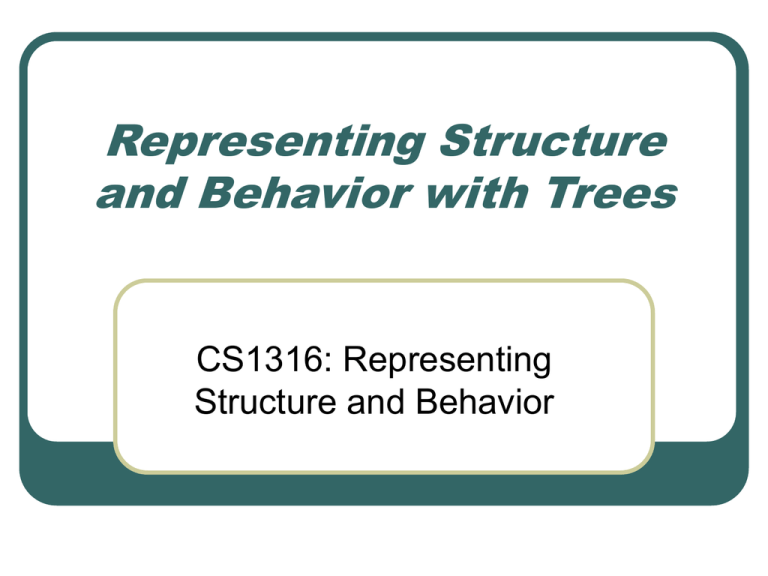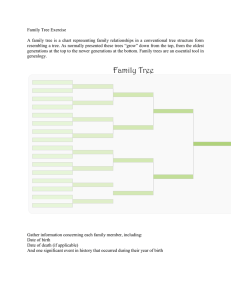Representing Structure and Behavior with Trees CS1316: Representing Structure and Behavior
advertisement

Representing Structure and Behavior with Trees CS1316: Representing Structure and Behavior Story What we were just doing with LLNode What linked lists are good for. • Using linked lists to represent structure and behavior What trees are good for. • Using trees to represent structure and behavior • Examples • Equations • Matching • Unification Abstracting LLNode abstract LLNode Knows next Knows how to do all basic list operations CollectableNode Knows just knows the part that specializes LLNode for collectable (sound-returning) nodes. DrawableNode Just specializes LLNode to represent things that can draw with a turtle and draw down their linked list with a turtle (drawOn). LLNode: The abstract definition of what a linked list node is Given LLNode, we can make anything we want into a linked list. Want a linked list of students? • Subclass LLNode into StudentNode • StudentNodes know names and ID numbers, • • and know how to access and return these. The linked list part is inherited from LLNode. Every StudentNode knows next and knows how to getNext, add, etc. Why do people use linked lists? Whenever you want dynamic size to the list, You may want the ordering to represent something, You want insertion and deletion to be cheap and easy, You are willing to make finding a particular item slower. Examples of Linked Lists Order of layers in Visio or PowerPoint Notes in a Phrase in JMusic Video segments in non-linear video editing. Items in a toolbar. Slides in a PowerPoint presentation. But what are trees good for? Trees represent hierarchical structure. • When just representing ordering (linearity) isn’t enough. Trees can store operations (behavior), as well as data. • Linked lists can, too, but not as useful. Examples of Trees Representing how parts of music assemble to form a whole. Representing the elements of a scene. • Representing the inheritance relationships among classes. • Scene graph Class hierarchy Files and directories on your hard disk. Elements in an HTML page. Organization chart Political affiliations Example Tree: Equation It’s fairly easy to turn an equation into a tree. • • 3+4*5 If you see an operation, make a branch. Otherwise, make a node. The structure here represents order of operation. Evaluating this tree is like collecting() the sounds, but collection involves computation (behavior) at the branches. + 3 * 4 5 Example Tree: Taxonomies (Keeping track of meaning) Let’s say that you want to compare prices at various websites for the same item. • • • At one site, they call it the “retail price” At another, they call it the “customer’s cost” How do you track that these are similar meanings? It’s the same as knowing that a MoveBranch is a kind of Branch is a kind of DrawableNode! Tree of Meanings Here, the arrows mean the same thing as in a class hierarchy. The thing below is a specialization of the thing above. Artificial Intelligence (AI) and Semantic Web researchers really do represent taxonomies in just this way. Price Retail price Customer price Customer cost Wholesale price Business-tobusiness price Algorithm for matching 1. 2. 3. Traverse the tree to find phrase1. Traverse the tree to find phrase2. Do both have a common ancestor (parent)? That’s the meaning in common! 4. If not, need to extend the taxonomy. Example tree: Unification My cat ate a fat worm. Sentence Diagrams are trees. Arrows don’t mean the same things here. • • Some arrows are saying instance-of a category (like “noun”) Other arrows are saying has-pieceswithin (like links from “subject” and “object”) ate verb subject object noun article cat noun adjective adjective a worm My fat How do we search a collection of sentence diagrams? Imagine: You’re an expert with the National Security Agency. You have megabytes of captured terrorist messages. Using specialized Natural Language Understanding (NLU) technology, you have trees of all this text. Now what do you do with it? Compare trees We can create a tree describing the kind of sentence that we want to find. We leave variables that can be bound in the process of the query. • Matching complex trees like this is sometimes called unification. Not exactly the same word? How do we determine if it’s close enough? See previous slides… attack verb subject noun object noun <suspect> <location in United States> Trees in User Interfaces Any user interface is actually composed of a tree! Windows hold panes hold buttons and text areas. Next lecture… window pane pane button text area button button



